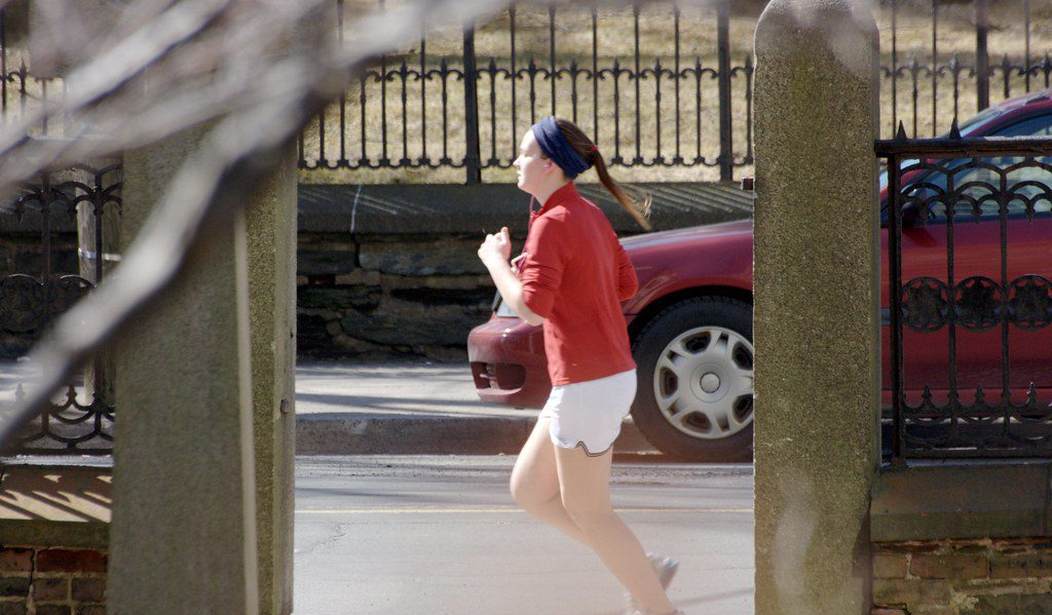I used to be a runner a long time ago. I ran track in high school and when that was over, I started running 5K road races. That served me well when I enlisted in the Navy since the runs weren’t particularly long for me.
But I don’t run anymore. From time to time, I’ll do some jogging, but only as part of a broader workout program that covers a lot of other things.
Jogging, however, is and probably always will be a popular way for people to try and get a little healthier. It has a low cost for initial entry and you can do it pretty much anywhere.
The problem is that some people can only jog at certain times of the day–often when it’s dark. For women, in particular, this is a scary time to be out and about alone.
Over at The Guardian, they talk about these concerns and even acknowledge some women run with firearms.
The majority of US women have worried about harassment while in public spaces during their lifetime. According to a 2019 national study on sexual assault by Stop Street Harassment and the University of California San Diego Center on Gender Equity and Health (GEH), 81% of US women have experienced some form of sexual harassment or assault.
For some women, threats while running are so significant that they’ve turned to carrying a concealed firearm.
…
Women who experience sexual harassment and assault while running agree that the effects are long-lasting and significant. But each woman who has been threatened while running is not identical, and neither are the stories of those who run with a gun.
Jamie, a 40-year-old runner who prefers to withhold her last name for privacy, says, “Women who carry while running are not monolithic, but we are often characterized as such in the media. We are characterized as right-wing, aggressive, backwards-thinking and ignorant of the risks of gun ownership. I am none of these. I am educated, politically moderate and sane.”
Jamie goes on to describe her own experiences. “I was followed around a popular lake trail by a man who exposed himself to me … about a half mile later, I heard steps behind me and it was him.” It was getting dark, and Jamie realized she was alone with the man, who she assumed was strong enough to overpower her. He came closer and closer, ignoring her entreaties to leave her alone, and backed her into some trees. Finally, “I put my hand on my [up until then concealed] pistol like I was about to draw and I told him to get away from me.” Suddenly, Jamie’s aggressor completely changed his demeanor, telling her to, “stay safe”, and running away.
Of course, not everyone agrees that carrying while jogging is a good idea.
Just a few paragraphs after the above-quoted section, they have this:
Not everyone is an advocate for carrying guns. David Hemenway, PhD, a professor of Health Policy at the Harvard TH Chan School of Public Health, does not recommend guns as a self-defense tool for runners. Hemenway says “when looking at data regarding defensive gun use in the National Crime Victimization Survey (NCVS), there was no evidence that gun use reduced the likelihood of injury during attacks on women.” Hemenway adds that the percentage of American women who carry a gun is small: in a 2016 Runner’s World survey of 4,670 runners, only 1% of women said they run with a gun.
However, there are a few factors that Hemenway is failing to consider.
First, that linked study was from 2009. That was during a definite downward trend in violent crime as a whole. As a result, that particular study is hardly relevant for today when violent crime is increasing.
Plus, there are reasons to question any such findings. Back in March, Cam discussed a piece from Reason about how gun control studies are, basically, worthless. One particular bit, from the original piece, includes this bit:
In terms of the gun control studies deemed rigorous by RAND, this means that even if there were no relationship between gun laws and violence—much like the relationship between drinking milk and getting into car accidents—we’d nevertheless expect about five percent of the studies’ 722 tests, or 36 results, to show that gun regulations had a significant impact. But the actual papers found positive results for only 18 combinations of gun control measure and outcome (such as waiting periods and gun suicides). That’s not directly comparable to the 36 expected false positives, since some combinations had the support of multiple studies. But it’s not out of line with what we would expect if gun control measures made no difference.
Also concerning is the fact that there was only one negative result in which the researchers reported that a gun control measure seemed to lead to an increase in bad outcomes or more violence. Given the large number of studies done on this topic, there’s a high statistical likelihood that researchers would have come up with more such findings just by random chance. This indicates that researchers may have suppressed results that suggest gun control measures are not working as intended.
In other words, citing a study saying a gun doesn’t make any women who carry while jogging safer doesn’t really mean anything.
Honestly, the entire thing at Reason is a must-watch/read if you haven’t already.
Further, at the risk of sounding like a feminist, Dr. Hemenway is a man. He’s not someone who will ever face the same fear that a woman out jogging in a remote area will face. It’s easy for him to dismiss those concerns.
Now, with all that said, no one should consider a firearm as a substitute for common sense. Jogging in dangerous areas is stupid, even if you’re armed. However, it does increase the safety of women out jogging in remote locations or in the dark of early morning or at night.
We already know that 1.6 million defensive gun uses take place every year. Some of those are likely women like Jamie above, who never even had to fire the weapon and thus don’t make the studies Hemenway cites. I mean, she didn’t even have to draw hers, but that gun sounds like it helped keep her safe.
Claiming it doesn’t is just trying to excuse women getting hurt.








Join the conversation as a VIP Member